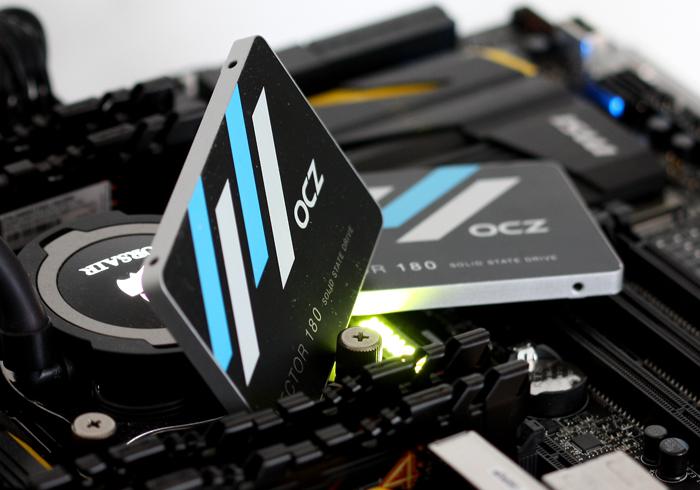Introduction
OCZ Vector 180 Series SSDs - Familiar with new features
We review the all new OCZ Vector 180 - 480 and 960GB SSDs. Based on an Indilinx Barefoot 3 controller the product comes with the latest iteration of Toshiba NAND flash memory. The end result is an SSD series that is very fast, versatile and competitive in terms of pricing; combine that with endurance and power outage protection and this series might be a little gem. Compared to the Vector 150 you'd at first think there aren't many changes, but there are...
Performance wise you are looking at a product series that ranks high up there with the others with speeds running towards 550 MB/sec on reads and even 530 MB/sec on writes, but there are some cool new options. Among others you can now pick a 960GB model, a volume size that is growing rapidly in popularity. That's next to 120, 240 and 480 GB versions of course. Durability and endurance are two factors that breathe and ooze reliability. In today's review for example we'll look at the product and see how fast it remains even after thrashing the SSD with over 3TB host writes written. Next to that there is one other feature we must mention, OCZ has embedded Power Failure Management Plus into this drive. It is a feature that MANY, if not all of us will really like. You will spot a capacitor on the PCB. In case of a crash or sudden power loss, the SSD will now have enough power to safely shutdown.
Now I must state that this feature is not similar to what we see in enterprise SSDs, but there are capacitors to ensure that data that has been written and 'rest' on the NAND partition is safe. The difference to enterprise class SSDs however is that data in the DRAM buffer will still be lost in the case of sudden power loss. However, this drive will get back to business as usual after a power loss as the NAND mapping table will not get corrupted and thus brick the SSD. It can recover, and that is a mighty fine feature to see embedded. The Vector 180 series isn't shy with writing either, this SSD series is rated at 50GB per day for five years. And that is guaranteed in the 5 year warranty that is now based on ShieldPlus (we'll explain what that entails in the conclusion). The end result is an SSD that is very fast and competitive in terms of pricing; combine that with endurance and you will get a very sexy SSD series. OCZ will release the Vector 180 series SSDs in capacities of 120GBG, 240 GB, 480 GB and 960GB. The SSD series is of course 2.5" for desktop and notebooks. Sequential read performance is listed as up-to 550 Mb/s with writes up-to 530 MB/sec depending on the volume size of the SSD that is. The handsome three offer 4K random access throughput of up to 100,000 IOPS (read) (depending on volume size). These SSDs are once again based on OCZ's Indilinx Barefoot 3 and Toshiba-made A19nm Multi-Level Cell (MLC) NAND flash chips. In fact, the SSD resembles the OCZ Vector 150 and ARC 100 series more than a little. Fun thing is though that the SSD has been tweaked a bit, making it very fast and competitive.
Competitive is the key word for this review as over the past month or two the dynamics are changing fast, players like Samsung and Micron (Crucial) have introduced new SSDs that bring the market down to its knees really. It was only last year that we wrote that SSD prices settled at just under 1 EURO per GB for the end-user, in the beginning of the year prices have been hovering at 70 cents per GB and currently you can already find SSDs priced at 35 Cents (EURO) per Gigabyte of storage volume. So with that in mind nobody can stay behind. A better pricing model combined with impressive performance is key to OCZ, now you can combine that with endurance, lifespan and power-loss protection as well. Very fast performance versus reliability is what that is all about, and OCZ wants to give you the best and made a new combo out of that.
Models
- 120GB - 550 MB/sec Read - 470 MB/sec Write
- 240GB - 550 MB/sec Read - 530 MB/sec Write
- 480GB - 550 MB/sec Read - 530 MB/sec Write
- 960GB - 550 MB/sec Read - 530 MB/sec Write
OCZ Vector 180 Series SSD with A19nm Toshiba MLC NAND and the Indilinx Barefoot 3 controller


